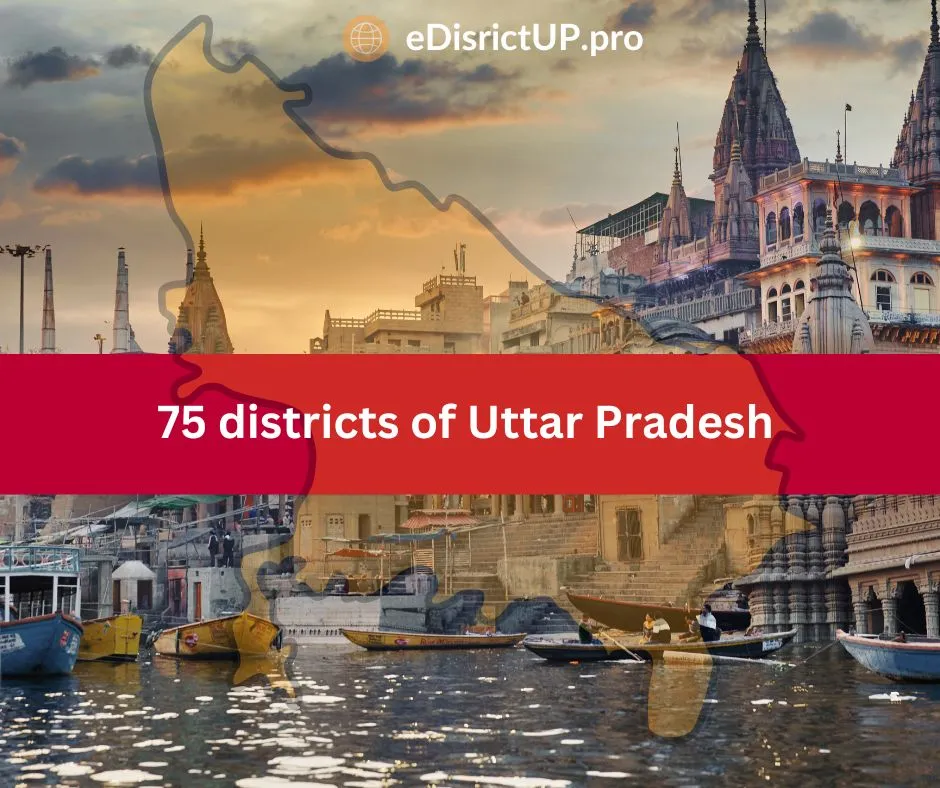75 districts of Uttar Pradesh
75 districts of Uttar Pradesh

Uttar Pradesh, one of India’s largest states, is divided into 75 districts. Each district has its own unique culture, economy, and administrative setup. These districts help manage the state effectively by organizing governance and development at a local level.
The districts vary widely in size and population. Some are hubs of industry and education, while others focus more on agriculture and traditional crafts. Understanding these districts offers insight into the diversity and complexity of Uttar Pradesh.
The division into 75 districts allows better delivery of government services and helps to address the needs of different regions within the state.
- Uttar Pradesh is divided into 75 distinct districts.
- Each district has its own role in the state’s administration.
- Districts vary in size, population, and local focus.
Overview of the 75 Districts of Uttar Pradesh
The districts of Uttar Pradesh vary in size, population, and location. They are organized to help manage the state’s administration efficiently. Each district serves as a key unit for governance and development.
Geographical Distribution
Uttar Pradesh has 75 districts spread across four main divisions: eastern, western, central, and Bundelkhand regions. The districts cover diverse terrains like fertile plains, forests, and river basins. The Ganges River flows through many districts, influencing agriculture and settlement.
Some districts are densely populated, such as Lucknow and Kanpur, while others like Sonbhadra are more rural and forested. The size of the districts also varies, with bigger ones in the Bundelkhand region and smaller ones near urban centers. This distribution affects economic activities and infrastructure development.
District Administrative Structure
Each district is headed by a District Magistrate (DM), an officer responsible for law, order, and local governance. The DM coordinates with police, revenue, health, and education departments within the district. This role ensures smooth administration and implementation of government schemes.
Districts are divided into smaller units called tehsils or subdivisions. These units help manage land records, taxation, and legal matters. Local bodies, like municipalities and panchayats, work under the district administration to handle urban and rural governance. This structure supports effective management across all 75 districts.
Regional Breakdown of Uttar Pradesh Districts
Uttar Pradesh is divided into distinct regions, each with unique features. These areas differ in culture, economy, and geography. The districts are grouped into Western, Central, and Eastern parts.
Western Uttar Pradesh
Western Uttar Pradesh consists of about 20 districts. This region is more industrialized and urban compared to others. It hosts major cities like Meerut, Ghaziabad, and Noida, which are close to the national capital, Delhi.
Agriculture is also strong here, with crops like sugarcane and wheat. The region benefits from better infrastructure and road networks. This has helped growth in manufacturing and services sectors.
The culture is a mix of modern and traditional. The population includes various communities, and Hindi, along with regional dialects, is widely spoken.
Central Uttar Pradesh
Central Uttar Pradesh has roughly 25 districts. It acts as a bridge between the industrial west and the rural east. Major cities here include Lucknow, Kanpur, and Allahabad (Prayagraj).
This region is important for politics, education, and administration. Lucknow, the state capital, is a cultural and political center. Industries are present but less dense than in the west.
Agriculture remains vital, with crops like rice, wheat, and pulses. The Ganges River flows through this area, supporting irrigation and trade.
Eastern Uttar Pradesh
Eastern Uttar Pradesh covers about 30 districts. It is the most rural and less developed compared to the other two regions.
The area depends mostly on farming, growing crops such as rice, sugarcane, and mangoes. It has fewer large cities, with Varanasi and Gorakhpur being the main urban centers.
Poverty and infrastructure challenges are higher here. The region also has rich cultural and religious heritage sites, attracting tourism. Many languages and dialects are spoken, showing strong local identities.
List of 75 Districts of Uttar Pradesh
1. Agra Division
- Agra
- Firozabad
- Mainpuri
- Mathura
2. Aligarh Division
- Aligarh
- Etah
- Hathras
- Kasganj
3. Prayagraj (Allahabad) Division
- Prayagraj
- Fatehpur
- Kaushambi
- Pratapgarh
4. Azamgarh Division
- Azamgarh
- Ballia
- Mau
5. Bareilly Division
- Bareilly
- Badaun
- Pilibhit
- Shahjahanpur
6. Basti Division
- Basti
- Sant Kabir Nagar
- Siddharthnagar
7. Chitrakoot Division
- Banda
- Chitrakoot
- Hamirpur
- Mahoba
8. Devipatan Division
- Bahraich
- Balrampur
- Gonda
- Shravasti
9. Gorakhpur Division
- Gorakhpur
- Deoria
- Kushinagar
- Maharajganj
10. Jhansi Division
- Jhansi
- Jalaun
- Lalitpur
11. Kanpur Division
- Kanpur Nagar
- Kanpur Dehat
- Auraiya
- Etawah
- Farrukhabad
12. Lucknow Division
- Lucknow
- Hardoi
- Lakhimpur Kheri
- Raebareli
- Sitapur
- Unnao
13. Meerut Division
- Meerut
- Bagpat
- Bulandshahr
- Ghaziabad
- Hapur
- Gautam Buddha Nagar (Noida)
14. Mirzapur Division
- Mirzapur
- Bhadohi (Sant Ravidas Nagar)
- Sonbhadra
15. Moradabad Division
- Moradabad
- Amroha
- Bijnor
- Rampur
- Sambhal
16. Saharanpur Division
- Saharanpur
- Muzaffarnagar
- Shamli
17. Varanasi Division
- Varanasi
- Chandauli
- Ghazipur
- Jaunpur
18. Ayodhya (Faizabad) Division
- Ayodhya (Faizabad)
- Ambedkar Nagar
- Amethi
- Barabanki
- Sultanpur
19. Vindhyachal Division (sometimes grouped with Mirzapur)
- Sonbhadra (Already listed above under Mirzapur Division)